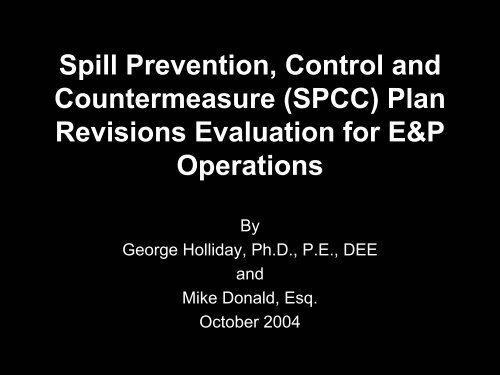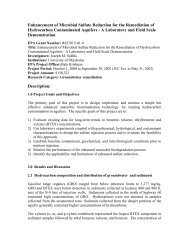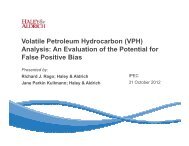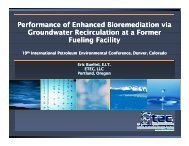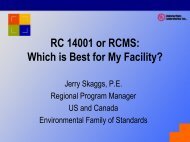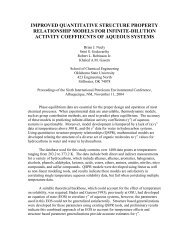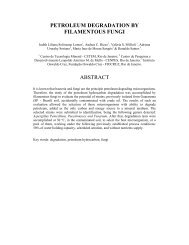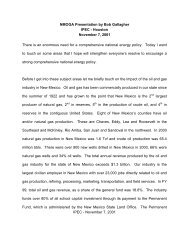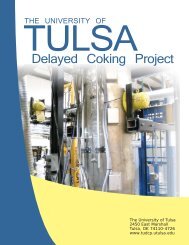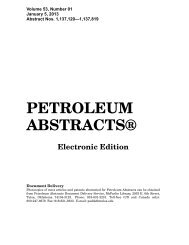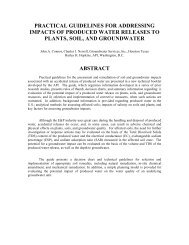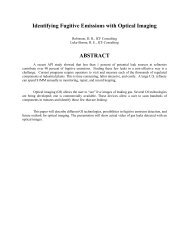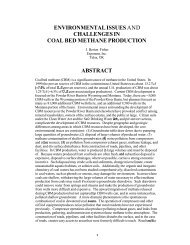Spill Prevention, Control and Countermeasure \(SPCC\) Plan ... - IPEC
Spill Prevention, Control and Countermeasure \(SPCC\) Plan ... - IPEC
Spill Prevention, Control and Countermeasure \(SPCC\) Plan ... - IPEC
You also want an ePaper? Increase the reach of your titles
YUMPU automatically turns print PDFs into web optimized ePapers that Google loves.
<strong>Spill</strong> <strong>Prevention</strong>, <strong>Control</strong> <strong>and</strong><br />
<strong>Countermeasure</strong> (SPCC) <strong>Plan</strong><br />
Revisions Evaluation for E&P<br />
Operations<br />
By<br />
George Holliday, Ph.D., P.E., DEE<br />
<strong>and</strong><br />
Mike Donald, Esq.<br />
October 2004
Where are we now?<br />
• Original SPCC <strong>Plan</strong> Rules published in<br />
1973<br />
• Revisions proposals examined in 1991,<br />
1993, <strong>and</strong> 1997<br />
• New Rules Revision Promulgated on<br />
July 17, 2002
Where are we now?<br />
• API, Marathon <strong>and</strong> Petroleum<br />
Marketers Association of America<br />
(PMAA) sued EPA<br />
• 29 March 2004 All litigants settled out of<br />
court regarding<br />
Loading rack definition –E&P truck loading<br />
facilities are not loading racks
Where are we now?<br />
Resolved<br />
Definition of “Practicable” – requires ring levee<br />
at drilling sites <strong>and</strong> pressure testing of flowlines<br />
Produced Water – produced water from dry gas<br />
well are exempted SPCC <strong>Plan</strong> inclusion.<br />
Produced water from liquid hydrocarbon<br />
producing are consider oil.<br />
Definition of facility – the definition contained<br />
in 112.2 at 69 FR 47142 applies
Where are we now ?<br />
Resolved<br />
All previously submitted requests fo<br />
extension are invalidated<br />
A new request for extension must be<br />
submitted<br />
The 1973, as amended, SPCC <strong>Plan</strong> must be<br />
maintained until revised <strong>Plan</strong> implimemted
Facility<br />
• All mobile or fixed installation, equipment, pipe<br />
or pipeline used during oil & gas drilling,<br />
producing, storing, gathering, processing, or<br />
transferring<br />
• Includes: Drilling rig storage, tank batteries,<br />
flowlines, gathering lines, separators, heater<br />
treaters, heaters, produced water tanks,<br />
compressors, etc. each container having a volume<br />
of ≥ 55 gal..
Where are we now?<br />
Resolved<br />
Oil container integrity testing – visual inspection is<br />
acceptable for shop-made containers
Where are we now?<br />
Unresolved<br />
Definition of Navigable Waters – in litigation. 5 th<br />
Circuit dictum exempts borrow ditches <strong>and</strong><br />
intermittent streams not adjacent to in-fact navigable<br />
streams are not Navigable Waters within Texas,<br />
Louisiana <strong>and</strong> Mississippi.<br />
Compliance date extension – EPA is evaluating<br />
Definition of a “small facility” – EPA is considering<br />
the definition<br />
Definition of diked area “capable of containing oil”<br />
– this issue has been lost in the system
Where are we now?<br />
Unresolved<br />
• Reserve Pits<br />
Drilling contractor include the reserve pit as a<br />
spill container in their SPCC <strong>Plan</strong>s, but do not take<br />
responsibility for the pit<br />
IADC states the reserve pit is the operator’s<br />
responsibility<br />
We believe reserve pits should be includes as part<br />
of the Drilling Contractor responsibility, because<br />
the Contractor directs all releases to the pit.<br />
It is not logical for the Contractor to have a release<br />
<strong>and</strong> then impose the responsibility on the operator
Original Rule Concept<br />
• Useful compromise worked out between<br />
API <strong>and</strong> EPA in 1973<br />
Compromise allowed discretion (e.g. “should”<br />
instead of “shall”)<br />
Professional Engineer (P.E.) assigned the<br />
discretion of determining plan adequacy.
New Rule Concepts<br />
• More rigid controls – P.E. discretion<br />
eliminated<br />
• P.E. attests plan conforms to SPCC Rules<br />
• P.E. accepts greater liability for plan failure<br />
• Field gathering line inspection <strong>and</strong><br />
maintenance plan<br />
• Many, many more...........
Rule Applicability<br />
• Non-transportation related onshore <strong>and</strong> offshore<br />
(State waters) facilities<br />
• Facility location reasonably expected to release oil<br />
causing a sheen on Navigable Waters.<br />
• Applies to producers, sellers, storers, refiners or<br />
users having hydrocarbon containers ≥55 gal<br />
capacity totaling >1320 gal
Exceptions :<br />
• Underground tanks ≤ 42,000 gallons covered by<br />
40 CFR 280 or 281<br />
• Above ground storage capacity ≤ 1320 gallons<br />
• Containers < 55 gallons<br />
• Drilling, well servicing <strong>and</strong> production facilities<br />
covered by DOT rules<br />
Examples: moving from location to location or<br />
regulated common carrier pipelines<br />
• OCS facilities under MMS control<br />
• Permanently closed containers & pressure vessels<br />
• Dry gas facilities (no condensate)
Major Rule Changes<br />
• Different types of oil h<strong>and</strong>ling facilities<br />
detailed in regulations, e.g., farmers<br />
• Exempts buried tanks ≤ 42,000 gallons<br />
• Eliminates 660 gallon threshold; Uses new<br />
1320 gallon threshold<br />
• Exempts wastewater treatment containers,<br />
but not produced water containers
Major Rule Changes<br />
• New release reporting requirements<br />
• New Professional Engineer requirements<br />
• New compliance/implementation dates –17<br />
February 2006/18 August 2006<br />
• Include 55gal containers
New Key Applicability<br />
Definition:<br />
• Any portable or fixed onshore /offshore<br />
building, structure, installation, pipe or<br />
pipeline (other than a vessel or a public<br />
vessel) used in oil drilling, producing,<br />
refining, storing, gathering, processing,<br />
transferring, distributing <strong>and</strong> waste<br />
treatment not under.regulatory control of<br />
DOT, or DOI .
When do the plans have to<br />
be prepared?<br />
• Existing fixed & mobile facilities must prepare<br />
plans by 17 February 2006 <strong>and</strong> implement by 18<br />
August 2006. In the mean time, the 1973 rule, as<br />
amended, apply, if operator continues to comply<br />
(69 FR 48794)<br />
• New facilities, must prepare & implement <strong>Plan</strong>s<br />
by 18 August 2006<br />
• Facilities becoming operational after 18 August<br />
2006 must implement plans before start-up
What are the Professional<br />
Engineer’s<br />
Responsibilities?<br />
• Attests to:<br />
being familiar with SPCC rule requirements<br />
having he/she or agent visited the facility<br />
plan prepared in accordance with good<br />
engineering practice <strong>and</strong> applicable industry<br />
st<strong>and</strong>ards<br />
having established procedures for required<br />
inspections<br />
plan is adequate & appropriate for the facility
What are the Facility<br />
Owner’s Responsibilities<br />
• Maintain a plan copy on site, if manned four<br />
or more hours/day<br />
• Have plan available for regional<br />
administrator to review<br />
• Attest to the <strong>Plan</strong> review at a minimum of<br />
once every 5 years <strong>and</strong> the need to amend or<br />
not amend the <strong>Plan</strong>
Can the <strong>Plan</strong> Preparation<br />
Time be Extended ?<br />
The Regional Administrator may Extend the plan<br />
preparation time, only, if he/she finds the<br />
owner/operator cannot prepare the plan in a timely<br />
manner because of:<br />
Lack of qualified P.E.<br />
Delays in Construction<br />
Equipment Delays<br />
If not caused by owner/operator
Reporting Requirements<br />
• If the facility has a discharge of >1000 gallons in a<br />
single incident or >42 gallons in each of two<br />
discharges within a rolling 12 month period the<br />
operator must:<br />
report the release to EPA & the Nation Response<br />
Center<br />
forward the EPA report to State Agencies – do not send<br />
<strong>Plan</strong><br />
follow Regional Administrator’s (RA) instructions to<br />
amend the plan<br />
amend your plan<br />
have right to appeal RA Instructions within 30 days
Information Required by the<br />
RA, if you have a Reportable<br />
Release<br />
• Name of facility<br />
• Name of operator representative<br />
• Facility Location<br />
• Maximum storage capacity <strong>and</strong> daily throughput<br />
• Corrective actions <strong>and</strong> countermeasures taken<br />
• Description of facility, maps, flow diagrams etc.<br />
• Cause of oil release<br />
• Additional preventive measures taken
When must a <strong>Plan</strong> be<br />
Amended?<br />
• Within 6 months of changes in :<br />
Facility design<br />
Construction, operation, or maintenance<br />
affecting potential to release oil<br />
Construction or removal of secondary<br />
containment<br />
• Implement within 6 months of revised <strong>Plan</strong><br />
preparation
What about Review <strong>and</strong><br />
Evaluation of the <strong>Plan</strong>?<br />
• <strong>Plan</strong> must be reviewed <strong>and</strong> evaluated every<br />
5 years<br />
• New technology or improved measures<br />
trigger review<br />
• New measures must be in place 6 months<br />
after the review completed<br />
• Review must be dated & attested to by<br />
owner/operator
Rule Overall Structure<br />
• General requirements apply to all onshore<br />
& offshore facilities<br />
• Specific requirements are added to the<br />
general requirements for producing, drilling<br />
& workover operations individually for<br />
onshore <strong>and</strong> offshore
General Requirements<br />
• Discuss how the <strong>Plan</strong><br />
conforms to the rule<br />
• If <strong>Plan</strong> deviates from the<br />
rule, how does your<br />
proposal provide<br />
equivalence<br />
• Describe the facility<br />
layout<br />
• Provide a flow diagram of<br />
facility showing piping,<br />
containers, pumps <strong>and</strong><br />
piping<br />
• List<br />
type of hydrocarbon in each<br />
container<br />
release prevention<br />
procedures available when<br />
transferring oil, loading &<br />
unloading<br />
Release <strong>and</strong> drainage<br />
controls<br />
<strong>Countermeasure</strong>s for<br />
discovery, response &<br />
cleanup
General Requirements<br />
• List methods of recovered<br />
material disposal<br />
• Contact list & phone<br />
numbers<br />
facility response<br />
coordinator<br />
National Response<br />
Center<br />
cleanup contractors<br />
having a written<br />
agreement with the<br />
operator<br />
• Release-reporting<br />
procedures, either<br />
from Response <strong>Plan</strong> or<br />
developed for SPCC<br />
<strong>Plan</strong><br />
• Describe control<br />
measures & available<br />
support materials
General Requirements<br />
• If experience dictates a<br />
potential for releases,<br />
predict the direction of<br />
release flow<br />
rate of flow<br />
quantity of flow<br />
• Provide containment or<br />
diversionary structures to<br />
prevent hydrocarbon from<br />
entering navigable waters<br />
• Onshore<br />
berms, dikes, retaining<br />
walls<br />
Curbing<br />
culverting, gutters or other<br />
drainage systems<br />
Weirs, booms & barriers<br />
<strong>Spill</strong> diversion ponds
General Requirements<br />
retention ponds<br />
sorbent materials<br />
• Offshore<br />
curbing & drip pans<br />
sumps & collection<br />
systems<br />
• Onshore/Offshore<br />
Impracticable provisions<br />
provide equivalent<br />
protection<br />
explain why rule is not<br />
practicable & how the<br />
protection is equivalent<br />
If no Response <strong>Plan</strong><br />
available<br />
‣ For containers, provide a<br />
periodic integrity testing
General Requirements<br />
‣For piping & valves,<br />
periodic integrity &<br />
leak testing<br />
contingency plan<br />
written management<br />
commitment to provide<br />
manpower, equipment<br />
& materials<br />
• Prepare written<br />
procedure for required<br />
inspection & tests<br />
keep procedures with<br />
the <strong>Plan</strong>, & for three<br />
years, records of<br />
inspections & tests<br />
signed by the<br />
supervisor<br />
• Train your (contract?)<br />
oil-h<strong>and</strong>ling personnel<br />
in operation &<br />
maintenance of<br />
equipment
General Requirements<br />
designate a person who is<br />
accountable for oil release<br />
prevention<br />
at least once per year,<br />
conduct release prevention<br />
briefing for oil-h<strong>and</strong>ling<br />
personnel<br />
• Field-constructed tanks<br />
typically refer to fieldwelded<br />
tanks >1000 bbl<br />
capacity- if such tanks<br />
exist & are ≥1 in thick<br />
brittle fracture can exist<br />
if such tanks undergoes<br />
repair, alteration,<br />
reconstruction, or change of<br />
service, evaluate the<br />
container for risk of<br />
discharge & correct<br />
observed problem<br />
• Include in the <strong>Plan</strong> all<br />
state <strong>and</strong> local oil spill<br />
requirements
<strong>Plan</strong> Formatting<br />
• The format for <strong>Plan</strong> General Requirements<br />
must follow the prescribed (above)<br />
sequence<br />
Existing <strong>Plan</strong> may be update, but the General<br />
Requirements section must be cross-indexed to<br />
follow the above sequence
Onshore Production<br />
Facilities Requirements<br />
• Meet General<br />
Requirements<br />
• Keep dike drains closed<br />
& sealed (locked), except<br />
when in use<br />
inspect diked water before<br />
draining<br />
drain only uncontaminated<br />
rain water from diked areas<br />
Do not drain to a navigable<br />
waters<br />
• Schedule inspection of<br />
field drainage ditches<br />
Remove accumulated oil<br />
• Select tank materials<br />
compatible with the stored<br />
oil<br />
dike or drip pan all containers<br />
≥55 gals, separators, transfer<br />
pumps, heaters & heater<br />
treaters having a capacity of<br />
the largest container in the<br />
dike/pan + precipitation<br />
• Schedule regular container<br />
& foundation inspections
Onshore Production<br />
Facilities<br />
• Design/update tank<br />
batteries in accordance<br />
with good engineering<br />
practice<br />
adequate size tank, or<br />
Equalizer lines between<br />
tanks, or<br />
Tank vacuum protection, or<br />
High level sensor for<br />
computer controlled<br />
• Regularly scheduled<br />
inspection of piping &<br />
valves associated with<br />
oil transfers. Repair<br />
as required<br />
• Periodically inspect<br />
produced water<br />
treating facilities<br />
• Provide a flowline<br />
maintenance program
Onshore Drilling & Workover<br />
• Meet General Requirements<br />
• Position equipment to prevent releases to<br />
navigable waters<br />
• Provide ring level, catchment basin or<br />
diversionary structure to intercept releases<br />
• Install BOPE when drilling casing or<br />
working-over a well<br />
BOPE must be rated to control well
Offshore Oil Drilling,<br />
Producing or Workover<br />
• Meet General Requirements<br />
• Use collection system (curbing,<br />
drain pans, sumps etc.) to collect<br />
small discharges <strong>and</strong> leaks. Oil<br />
must be drained to a sump or<br />
removed<br />
• Sumps must be sized adequately<br />
<strong>and</strong> have a st<strong>and</strong>by pump.<br />
• Schedule inspection, testing &<br />
preventative maintenance of sump<br />
<strong>and</strong> sump pumps.<br />
• Equip atmospheric tanks & surge<br />
vessels with high liquid level shutdown<br />
valves or alarms<br />
Facilities<br />
• Provide high /low pressure shutdown<br />
valves or alarms on pressure<br />
vessels. Provide corrosion<br />
protection on containers, as needed<br />
• Prepare & maintain at the facility a<br />
written plan for inspecting <strong>and</strong><br />
testing pollution equipment <strong>and</strong><br />
systems<br />
Schedule periodic inspections of<br />
pollution equipment<br />
Conduct simulated (table top)<br />
discharges to test pollution control<br />
& countermeasure systems<br />
• Operating instructions/records of<br />
surface <strong>and</strong> subsurface shut down<br />
valves <strong>and</strong> activation
Offshore Oil Drilling,<br />
Producing or Workover<br />
Facilities<br />
• Install BOPE on wells, if<br />
drilling below casing shoe<br />
BOPE must be rated to control<br />
well<br />
• Install check valves at well<br />
headers on each flowline<br />
• If well surface press exceeds<br />
flowline working pressure,<br />
install flowline high pressure<br />
sensors <strong>and</strong> shut-down valves<br />
• Provide corrosion protection on<br />
piping leading to <strong>and</strong> from<br />
facility<br />
• Maintain sub-marine piping in<br />
good condition<br />
routinely according to a<br />
schedule inspect or test submarine<br />
piping<br />
Document & keep inspection<br />
records with the <strong>Plan</strong>
Conclusions<br />
• We expect no more extensions of the SPCC<br />
<strong>Plan</strong> implementation (17 February 2006) &<br />
compliance dates (18 August 2006)<br />
• Existing <strong>Plan</strong>s must be re-written, because<br />
cost of formatting requirements & including<br />
new provisions
Conclusions<br />
• Maintain all provisions of existing <strong>Plan</strong> –<br />
this will provide continuing compliance<br />
• Anticipate an additional two-year extension<br />
for small facilities, as yet undefined. (69 FR<br />
38297)
Recommendations<br />
• The SPCC <strong>Plan</strong> rule is in flux:<br />
Maintain existing SPCC <strong>Plan</strong>s in<br />
accordance with the 1973 rule<br />
New facility SPCC <strong>Plan</strong> – prepare SPCC<br />
based on the suggested template provided<br />
Recognize the template has not been<br />
sanctioned by EPA, but appears to contain<br />
the rquired minimum plan elements.


